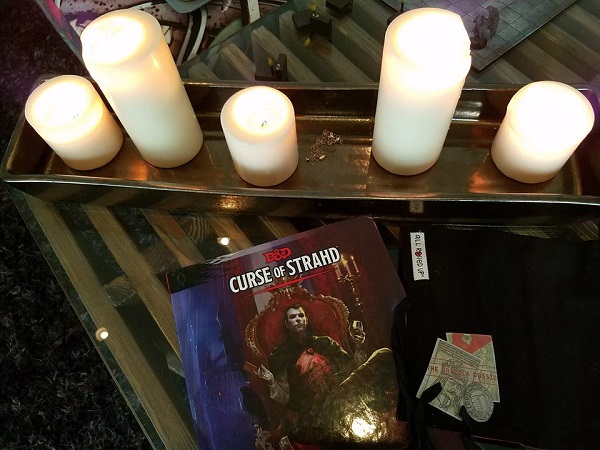GM Tips Our series to help Storytellers and Game Masters improve their craft and create memorable roleplaying experiences. Last week, we wrapped up the last of the video series with a discussion on campaign close out. This week we look to a new adventure and the bare tools needed to start a storytelling career.
We’ve covered both tips for beginners and pros in the past; but one comment keeps popping up more often than not. The tips don’t help people who don’t have a group—or some variation thereof. Ultimately, all games start because a storyteller is willing to take the plunge and start running games. Like any proper wilderness scout (or post-apocalyptic survivor) all GM’s have tools in our kit to get started. I hit up some friends for pictures of their setups, so let’s go over some handy items for any GM Kit and then convince all of you to share your kits as well.
The Physical Goods

The list below comprises what I feel is the most barebones GM tools anyone needs to really get started to launch a campaign. Even if you digitize the tools and use online dice rollers, you are still using dice. I really suggest that when starting a fresh game you invest in custom character sheets. There is a charm that is hard to replicate when you sit with a single player and create a custom sheet and give them ample places to doodle. I also do believe that you can start a game without any GM guide or monster manuals. All you truly need is the main base book. Here’s what I’d suggest you get:
- Character Sheets (bonus for custom/ illustrated character sheets)
- Dice (get enough that you can lose several under a couch and not worry for a week or two)
- The core rulebook (though hopefully it is well read by this point)
- Mechanical pencils and an eraser (hide every damn pen in sight – seriously)
- Your basic first-day-of-school Trapper Keeper with folders
- Grid Map and Marker
- Random odd shaped objects in place of figurines (I can only imagine the horrors those snowmen above induced)
The Narrative

There are five elements of a story, plan your first adventure around one game session for each. The Setting, The Characters, The Plot, The Conflict, The Resolution. We’ll expand on this more in another article, but any game or GM toolbox needs a storyline in order to begin. Convention adventures that are built to run within a four-hour time slot are often billed as great starting adventures, but I tend to find them lacking in many regards for launching a long-term campaign.
Instead, practice writing out 12 quick hit plot trees with these five elements and save them in your GM Kit folder. Leave them generic so that you can use them in future games or even cross-genre. One example is a quick heist game that describes a bank vault, a cast of colorful NPCs, a reason that vault needs to be cracked, the security that players will overcome, and the various options of payout is an easy one that can be used as a side adventure with many branching paths.
Special Effects

Finally, you want to do add something that makes your storytelling style personal. For me, it’s a Bluetooth speaker and my phone. Picking out not only songs for my players’ characters, but the right mood music, or theme song, for every location and NPC. I know other GM’s that spend the day of game cooking a meal based on the town the players will be entering. Some GMs, like Jason Carl, create pretty elaborate setups:

If that’s not your thing, a special tokens for your players (like inspiration tokens) might be. Incense, for example, was one of Satine Phoenix’s special element that she uses to set the mood. Ultimately, the point of this tip is to convince you to look around and find something personal to you—that you can bring into the game. This extra effort in special effects will also help set a routine for yourself when you should be “on” and will help with any jitters or nerves you may have when getting started for the first time.
So what’s in your GM Tool Kit? Share a picture on socials (@geekandsundry) or let us know in the comments below!
Looking for More Useful GM Tips?
- Enhance combat encounter tension with these tips!
- Get a handle on how to run multiple story lines.
- Shop the Geek & Sundry store for DM gear, like a “How Do You Want to Do This” hoodie!
Featured Image: Initiative Coffee Co
Image Credits: Matt Doser, Jameson Hogan, and Jason Carl
Rick Heinz is the author of The Seventh Age: Dawn, and a storyteller with a focus on LARPs, Wraith: The Oblivion, Eclipse Phase, and many more. You can follow game or urban fantasy related thingies on Twitter or Facebook.